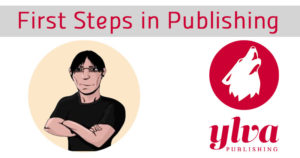Curious about what it takes to create good lesbian fiction covers? Designer and cover artist Glendon Haddix reveals the big tips and slips made when putting out book covers.
Tell us some important, funny, or unusual things about yourself
I love heavy metal music. The harder, faster, and heavier, the better.
I worked in the corporate world for fifteen years and was a department manager for many of those. But I do not have a college degree.
How did you come to be a cover artist?
My wife wrote a book. I’d played around with graphics as a serious hobby for a while, so I did the cover for that book, and together we figured out all the formatting and publishing requirements. Then, after a little while, people starting asking who did the cover. Before we knew it, we had a start-up business on our hands. I worked evenings and weekends on that while working my full-time job as an engineering manager for a multi-million dollar manufacturing company. After a couple of years, we had so much business that I quit the day job and focused on Streetlight Graphics full time. Since then, I’ve never looked back.
What is the cover you are proudest of and why?
This is an extremely tough question. Probably because it is always changing. It’s usually the last cover that I did. But I would have to say that my wife’s covers are probably my favorite (www.tlhaddix.com and www.authoralexcollins.com). Probably because I’m biased though.
What is the one thing you wish you’d been told when you were starting out?
To bring people on board the team sooner. I worked close to a hundred hours a week for a very long time before we added to the team.
What was your biggest mistake and what did you learn from it?
I don’t think I have one big mistake, but I’ve made several smaller ones over the years. Misspelling a name on a cover and things like that are cringe-worthy. I learned in the detail-oriented industry of engineering, sometimes you just miss a detail. You can’t beat yourself up over mistakes, because they will happen. But how you handle them is everything. Take ownership, fix it quickly, be polite and respectful, and find out why it happened. Then take steps to prevent it from happening again.
What are the most common errors you see in badly designed book covers?
Usually it’s bad typography. For example, using fonts like papyrus or comic sans generally will not look good. And sometimes a bad Photoshop background manipulation/removal that can detract from a cover’s quality.
What have you learned about lesfic book covers that are different from hetfic covers? Are the women portrayed differently, for example?
Hetfic tends to have a different view on what is considered attractive. Usually hetfic prefers the female characters to be more “model-perfect” and “glossy,” while lesfic is much less concerned about those things.
Are there unwritten rules for certain genres when it comes to cover designs?
Sort of. If you look at the bestselling books in a specific genre, you will typically see that they all have a few things in common. Thrillers typically have something that gives the sense of motion and large blocky text. Romantic comedies are usually illustrated with bright colors. But these are more guidelines than hard and fast rules, as often times a book will break with convention and the cover needs to reflect that.
What kind of information do you need to know to design a good cover since we assume you don’t read the books?
The usual things like title, author name, etc. Then we ask for the genre and the synopsis, as well as titles of other books that the author feels have the same tone and feel as their book. As much as I would love to, I just don’t have enough available time to read all the books.
If someone wants to be a good cover designer, what tools and skills should they have?
Practice and experience will go a long way toward making a good designer. A good, solid business and work ethic will go toward making a great designer. The more you do anything, the better you will get at it, but an eye for design is something that a person really needs to have too, and you can’t really teach that. People either have it or they don’t.
As far as just tools go, I am always reading and watching tutorials about software and design theory, and we use a host of various software packages – Photoshop, Illustrator, After Effects, 3ds Max, just to name a few. For images, I mainly use Shutterstock, but occasionally we buy images from other sites. Also, since I have illustrators on my team, often we will draw what we need for a project versus buying photos to composite.
How long does the average book take to design – purely the design time spent on it.
This is a tough one to answer. Just the time in Photoshop to create the actual design and not the research, finding images, reading through information, and thinking about what you actually intend to design, then that is somewhere between one to four hours. It really depends on the project.
For example, if it’s illustrated, then we have to draw the elements—which can take longer than if we are compositing photos. Manipulating people usually adds a lot of time.
On average, I spend as much time doing the non-design part as I do on the actual design. I’ve used Photoshop for almost twenty years, so I tend to be pretty efficient with that part of the process, whereas the figuring out what that specific project takes however long it takes.
Glendon Haddix was born in southeast Kentucky. His father bought him a computer when he was five and he’s not been without one (or more) since. He went on to a successful career in product engineering where he worked his way up to engineering manager for a multimillion dollar company, but when his wife wrote her first book, he traded that career for the chance to start his own graphic design business. He hasn’t looked back because, as he puts it, “When you enjoy the work you do and the people you do the work for, you never dread walking into your office each morning.”
Ylva’s First Steps in Publishing blog series introduces people from all walks of life in the publishing business. Check out our interviews with US author KD Williams and up-and-coming Australian author Cheyenne Blue, talking about what they’ve learned along their writing journeys. Best-selling German author Jae reveals her experience of working full-time as a writer and editor. Also coming in November: Ylva publisher Astrid Ohletz lays bare the truth about this stressful but rewarding creative industry. We’ll keep you posted!



0 Comment